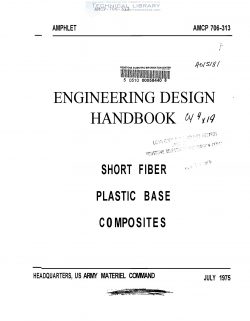AMCP-706-313
- Version
- 212 Downloads
- 6.25 MB File Size
- 1 File Count
- March 5, 2017 Create Date
- March 5, 2017 Last Updated
Engineering Design Handbook - Short Fiber Plastic Base Composites

The reinforced plastics, which are the subject matter Of the handbook, are identified conveniently as short fiber molding com- pounds in contrast to other materials with continuous or particulate reinforcements. They are defined, in simplest terms, as com- posites in which randomly distributed discon- tinuous fibers form a reinforcement phase and a thermoset resin serves as the matrix or binder. A dispersion of inert fillers may or may not be incorporated within the resin system. The fiber length is variable and may range from 1/8 in. or less to 3 in. or greater. Mechanically, the load transfer mechanisms and stress distribution are unique for the short fiber reinforcement. Strength properties cover a range between the continuous rein- forced at a higher level, and the particulates at a lower level. In terms Of specific commercial types, the short fiber compounds included in the hand- book are the relatively new sheet molding compounds (SMC) and the bulk molding compounds (BMC). To these are added the older preform wet molding systems and a group of compounds made from resin impreg- nated chopped reinforcements. SMC, BMC, and preform moldings are based on polyester resin systems with fiberglass reinforcements. The chopped roving materials most frequently use an epoxy binder and either fiberglass or graphite fibers as the reinforcing phase. Commercially, the more important mate- rials are SMC and BMG. These two material types comprise a major portion of the output
| File | Action |
|---|---|
| AMCP-706-313 Engineering Design Handbook - Short Fiber Plastic Base Composites.pdf | Download |

Comment On This Post